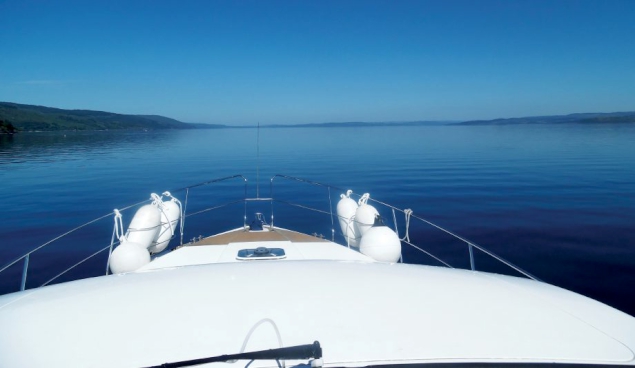
When a tidy used Broom 41 caught Keith Wheeler’s eye, he simply couldn’t resist her charms, whisking her away on a three-month maiden adventure from Plymouth to the Inner Hebrides
Sometimes in life a temptation is so great that you simply have to give in to it. After many years as a sailor, in February 2018 I suffered what the French call a coup de foudre, which roughly translates as ‘love at first sight’ – not with a leggy blonde but a beautifully proportioned Broom 41. A quick bit of man maths, permission from a very forgiving wife (who hates going to sea) and this object of desire was all mine. How’s that for self-indulgence when the year had barely begun?
The next bit of indulgence was to plan a three-month maiden voyage from Plymouth to the Inner Hebrides. Engines were serviced, the boat lifted and a list of jobs given to Nathan Bone Yacht Repairs to get her shipshape for our mid-May departure date.
In the meantime, I enlisted the services of long-time boating pal Colin to join me on our adventure. Over the years we have enjoyed many memorable cruises together in Europe, the Med and the Bahamas, and work together instinctively on a boat – a priceless attribute when things get hairy.
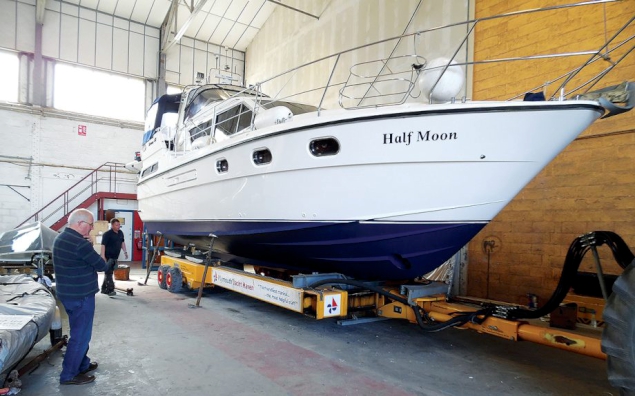 Keith’s Broom 41 prepped and ready to begin their adventure
Keith’s Broom 41 prepped and ready to begin their adventureBoth of us being retired meant there would be no time pressures, so if there was even the slightest doubt about the weather we wouldn’t need to press on. This trip was all about enjoyment, not endurance. Whilst the boat can happily travel at 25 knots, it’s not compulsory, and being a Broom it’s just as comfortable at displacement speeds, making very little wash and burning a fraction of the fuel.
As we filled up the tank ready for the first leg of our adventure, the guys on the fuelling berth asked where we were headed. They seemed suitably impressed with our destination but then asked if the boat’s owner was coming with us – patently
my sartorial standards fell far short of those expected of a Broom owner!
Cornish cream
We set a course for Falmouth in perfect motorboating weather and couldn’t believe our luck. As it was only an overnight stop we put into Falmouth’s visitor haven but even though we were early in the season the only suitable space was taken by a small daysailer, berthed smack in the middle of a pontoon large enough for both of us.
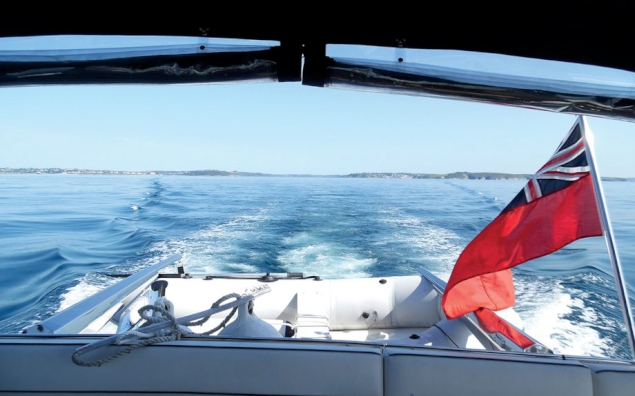 Setting off for Cornwall with Plymouth in her wake
Setting off for Cornwall with Plymouth in her wakeThankfully, the owners were just about to depart so we stood off while the entire extended family piled on to this tiny craft. For those of you old enough to remember, imagine an animated Giles cartoon with Gran, Auntie Vera, the dog and half a dozen children faffing about for 20 minutes before finally firing up the outboard in a cloud of fumes and pottering off.
We both enjoy working harbours and our next port of call was Newlyn. Home to a substantial fishing fleet, it used to have a reputation as being unwelcoming to leisure craft but we’ve never found it to be a problem. Since our last visit they’d put pontoons into the west corner of the harbour with a few specifically reserved for visitors.
We found a space and wriggled in before wandering into the town for supplies. On our return we felt the boat looked so out of place that we did a quick check of the tide tables and reckoned we had enough time to round Lands’ End at slack tide and make the passage up to Padstow before the lock gate shut.
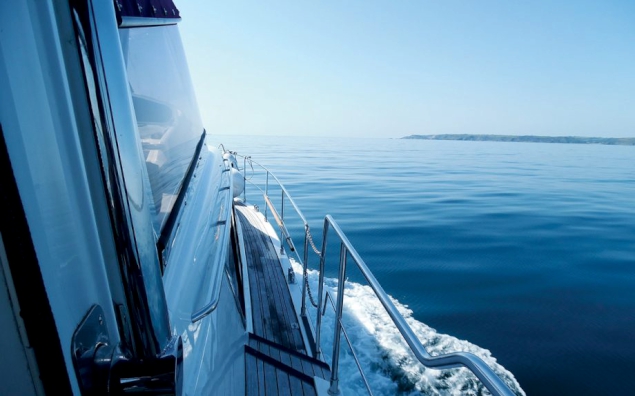 Approaching Land’s End on an eerily flat sea
Approaching Land’s End on an eerily flat seaNow, I am not the bravest mariner and I don’t think I have ever had a smooth passage in the many times I have been around Land’s End, so I could feel the butterflies building in my stomach as we set off into open water. However, the benign conditions prevailed and we swept around the point at 18 knots, giving thanks to Neptune as we passed, and on up to Padstow.
This Cornish town, known as ‘Padstein’ in honour of its most famous resident and restaurateur, Rick Stein, has always been a great place to stop so we stayed a few days to make the most of it. One evening at the London Inn, we fell into conversation with a chap who introduced himself as “Magic Phil”.
By day he repaired equipment for the hospitality industry but by night was a close-up magician. I still can’t work out how he replaced the coin in his hand with a small jar of honey! That’s the wonderful thing about cruising – you meet such interesting people.
Chartless in the Channel
When the time came to leave we rummaged through our portfolio of charts only to find that neither of us had brought the chart that covered the Bristol Channel crossing from Padstow to Milford Haven. Fortunately, as a back up, I had Belfield’s chart software on my laptop.
The passage was glorious with dolphins joining us for some of the crossing. Going in through the heads brought back a flood of memories as we recalled the fabulous times we enjoyed sailing out of the haven in the 1980s. Some of the hangovers we suffered after spending too much time in the Old Point House in Angle or the Griffin in Dale were less enthusiastically recalled. We tried to convince ourselves that we were both now older and wiser. Well, one out of two isn’t bad!
The forecast for the Irish Sea crossing from Milford Coastguard was F4/5 but Dublin Coastguard reckoned it was 2/4, which tallied with XC weather. We put our faith in XC, and Milford to Arklow started well as we flew past the islands on a flat sea with a light northerly, but it was too good to last.
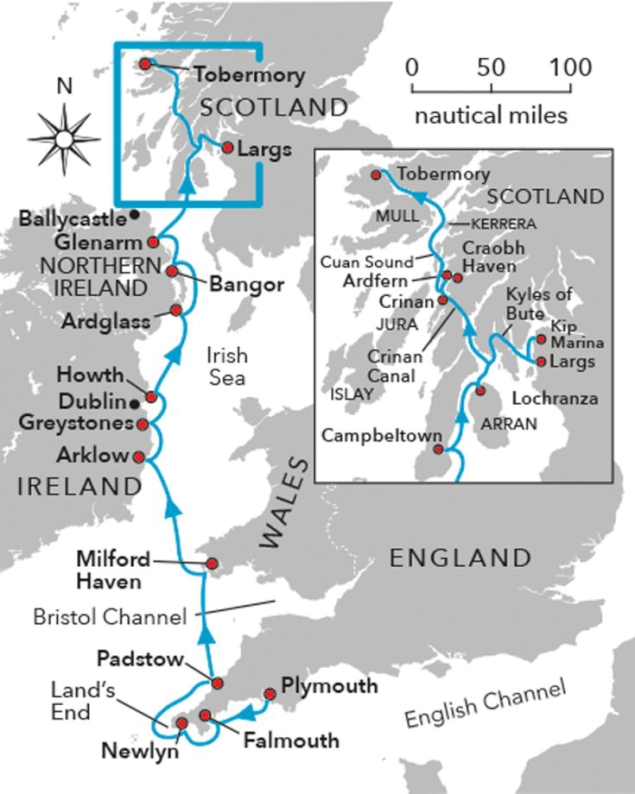
sea lumped up. We were glad to get into Arklow, despite the dereliction that greeted us. The marina was tiny and full, as were the river pontoons, but we managed to get a berth in the old dock. We toddled off for a Guinness in the Harbour Inn, which, this being Ireland, isn’t on the harbour but is a very welcoming place once you get there.
It looked as though the weather was going to be fairly unsettled for the coming week and we didn’t fancy spending it in Arklow, so we decided to push an adverse tide and wind in the hope of a smoother passage to Greystones. Greystones is a very sheltered marina but in my view overpriced, since at the time of our visit the shoreside was a building site and the facilities a portacabin – hopefully the work is finished by now.
There was no fuel but they arranged a road tanker for us to take on green diesel (the cheapest we found at 90.7ppl compared to £1.11 in Milford). The town, however, was very pleasant and we also entertained ourselves with cliff walks whilst the scruffy weather passed through.
Onwards to Ireland
The leg to Howth was dogged by very poor visibility and vigilance was required crossing the shipping lanes to Dublin. The welcome at Howth was somewhat less than cordial as they told us we could only stop one night because they were preparing for a large biennial regatta and if we had any doubts about the weather the following day we should move on now!
So the next day we set off for Ardglass, a tricky little place with not a lot of manoeuvring room. With a stiff F6 blowing straight across the pontoons, a couple of yachties wandered down to take our lines. As I turned broadside to the wind it was all I could do to keep the boat parallel as she was blown towards the pontoon at a rate of knots.
It was only after we were safely secured that the yachties admitted they were close to abandoning the pontoon, so certain were they that we were going to carry it away with us! Ardglass turned out to be a great little community-run marina with a tasty and good value restaurant a short walk away called Aldo’s.
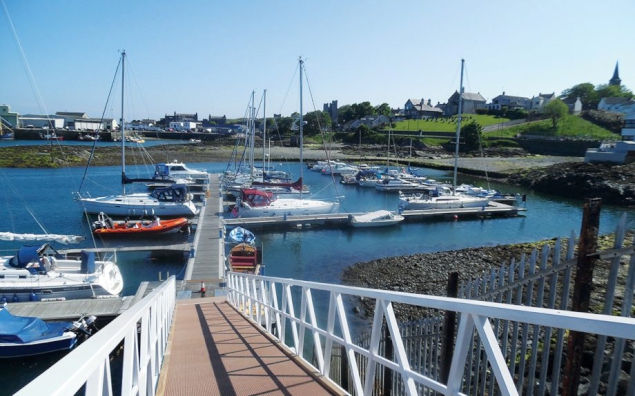 Ardglass Marina in Northern Ireland
Ardglass Marina in Northern IrelandNext stop, Bangor. The visitors’ berths are so far from the facilities they should bring you a golf cart to commute on, and the showers reminded me of my old school – half a century ago. On the plus side it’s only a short walk to Fealty’s, a typical Irish bar which serves the best Guinness I have ever tasted.
In a summer dominated by northerlies we finally had a following wind and favourable tide for the next leg. For once we were able to clearly see the coast – absolute magic, and our next port turned out to be a total gem. We arrived in Glenarm to the warmest of greetings from the harbour master and were even more delighted when told that £30 per night included use of the laundry, especially as we now had a mountain of washing to do.
That evening we visited one of the bars and asked if they did food. The answer was “no-yes”. In response to our confused look they explained that they did not do food but we could have food. Still none the wiser they produced takeaway menus from restaurants in the adjacent village. We duly placed our order at the bar, which they phoned through and when it arrived, they provided plates and cutlery so we and the yachties we had befriended in Ardglass ended up having a very jolly night!
Scotland beckons
By this point the evenings were getting a bit chilly and Murphy’s Law dictated that the heater chose this point to stop firing up. Originally we had planned to go to Ballycastle and then over to Jura but the nearest Eberspacher agent was Largs so we decided to divert into the Clyde and get it sorted. The trip started with a gentle underlying swell, however by the Mull of Kintyre and Sanda the wind had strengthened.
We had 2m white-topped waves on the nose so were relieved when we turned for Campbeltown. What a glorious approach as the sun came out and bathed the peninsula in golden light! To celebrate our arrival we booked a trip around the Springbank Distillery for the following day – an absolute must if you are a whisky fan.
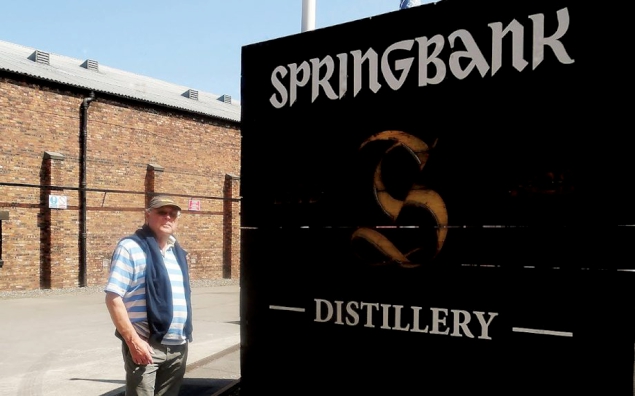 Sampling a wee dram at Springbank Distillery is a must when in Campbeltown
Sampling a wee dram at Springbank Distillery is a must when in CampbeltownNext was Lochranza on Arran. We picked up a well-maintained, community-run mooring (£15 in the honesty box) and revelled in what must be one of the most beautiful spots in the world. On our way to Largs via the stunning Kyles of Bute we picked up early warnings about storm Hector (F9 possibly 10) and began to consider where the best place would be to hide out.
In our opinion Largs was no place to be in a big blow from the west/ southwest so we headed over to Rothesay on Bute where we were totally sheltered in the inner harbour. Whilst on Bute we visited Mount Stewart house – the magnificent, but very quirky, home built by the Marquis of Bute (the former F1 driver Johnny Dumfries is the current and 7th Marquis).
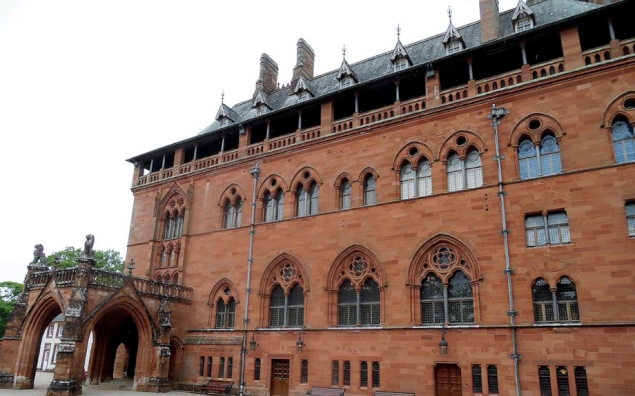 The impressive facade of Mount Stuart House on Bute
The impressive facade of Mount Stuart House on ButeWe had determined that Kip marina, with its rail station and proximity to Glasgow airport, was the best place for our wives to join us for the next and arguably prettiest section of our cruise. It turned out to be an excellent choice, not only were the facilities excellent but the staff went above and beyond.
There are a couple of good eateries within the marina and more in Inverkip village, which cater for most tastes and budgets. With wives on board we spent a glorious week exploring the lochs and islands of the Clyde before dropping my wife back at Kip whilst Colin’s wife Mary remained aboard for the trip to the Inner Hebrides.
The Crinan Canal is described as “Britain’s most beautiful shortcut” and at £155.60 for 9 miles it must certainly be the most expensive! Despite the hefty fee the only electrically operated locks are at both seaward ends, everything else is operated by hand with heavy gates and worn paddle gear making for hard work in the heat.
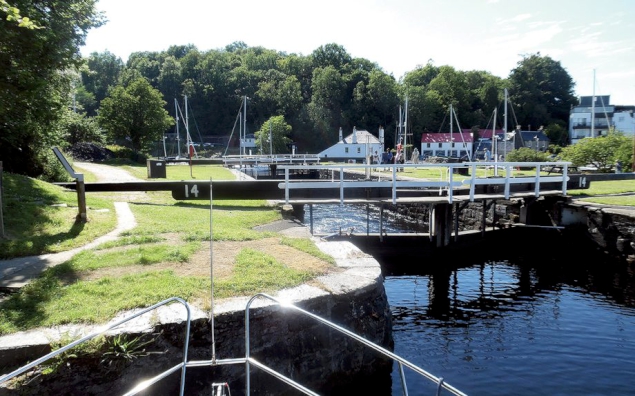 Navigating the locks on the way through the Crinan canal
Navigating the locks on the way through the Crinan canalAvoiding overgrown vegetation and rocks fallen in from the banking all add to the experience. It took all day to transit the canal without a break or time to take in the scenery, but when we exited the sea loch at Crinan we experienced what can only be described as a spiritual moment.
The vista before us of Jura, Scarba and Craignish Point in the late afternoon light was mesmerisingly beautiful. You can understand why early mariners’ charts carried the notation “here be dragons” – we felt like we had entered a totally different and unexplored world. At Ardfern Marina the size of the yachts with German, Dutch and Scandinavian flags in abundance underlined that we were now in the big boys’ playground.
The following day we set off through the notorious Dorus Mor which, despite being in a good mood, still had the power to spin the unwary with its powerful eddies. Craobh Haven was a wonderful stopover with views over Shuna, Luing and Seil before our next passage to Kerrera though Cuan Sound.
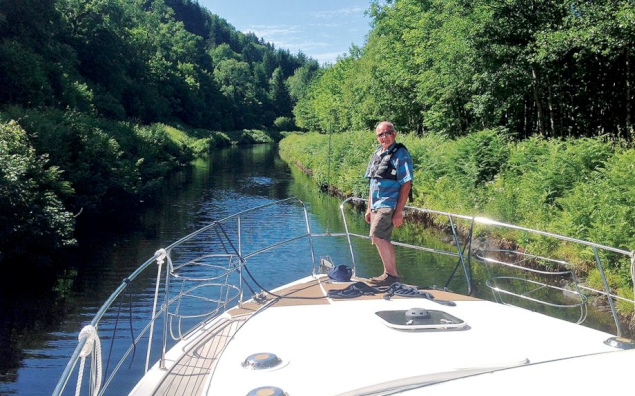 Colin keeps a look out from the bow
Colin keeps a look out from the bowThis 1nm-long V-shaped channel is less than 400ft wide at its narrowest and has a spring flow of 7 knots with submerged, unmarked rocks waiting to claim you if your pilotage is not spot-on. Collective breaths held, we squeezed through unscathed.
Cool runnings
We had been advised that the further north and west we went the cooler and windier it would become, and the sages were proved right. Leaving Kerrera and the Firth of Lorn we pushed on into the expanse of the Sound of Mull with a louring sky overhead, the effect of which was dissipated by our arrival at Tobermory with its famous multi-coloured waterfront. For a small place the volume of tourists from across the globe was unbelievable.
Regrettably, it was now time to start ambling back to Kip as Colin and Mary had commitments in August and my son and wife were due to arrive for a week’s holiday in and around the Clyde before the boat was shipped back to her Norfolk base.
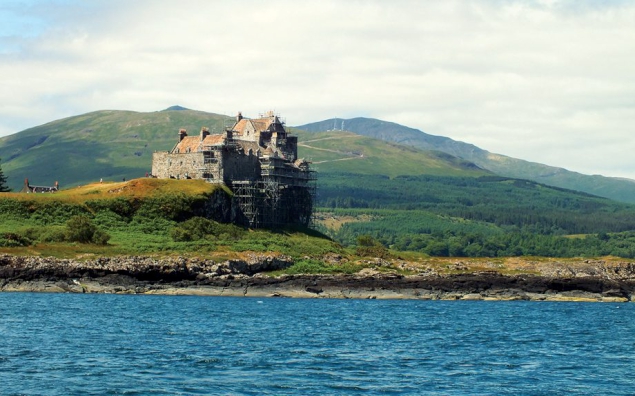 Duart Castle on Mull is the seat of Clan Maclean
Duart Castle on Mull is the seat of Clan MacleanCompared to my years spent sailing, I am still relatively new to motorboating so for me this was an amazing and educational trip, not least the ease with which we covered the miles regardless of wind or tide – in total we covered 1,112 miles and consumed 3,119 litres of diesel. In every sense, this was a self-indulgent start to my motor boating career, only made possible by having a very understanding wife.
But I’m happy to say that my initial coup de foudre with my Broom 41 has developed into a lasting relationship – she has proved to be an extremely comfortable, reliable and totally capable boat on which to spend three-and-a-half months. I am now looking forward to many more happy years together.
First published in the November 2019 edition of Motor Boat & Yachting.
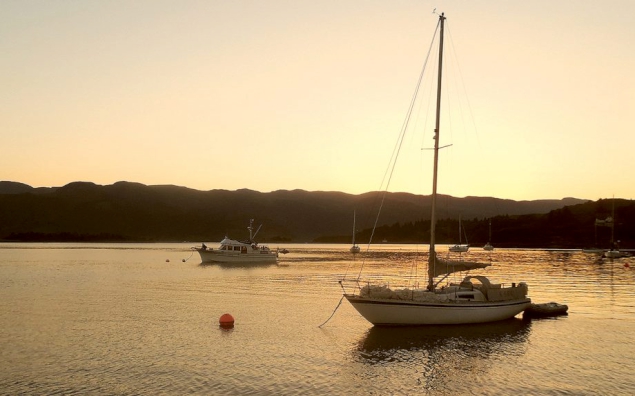
A tranquil evening in Colintraive
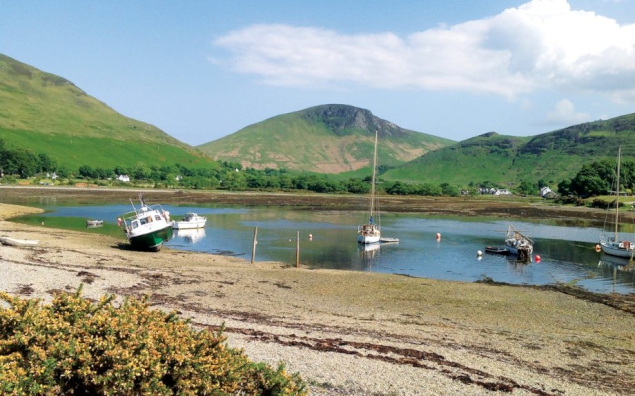
The moorings at Lochranza’s enjoy a spectacular setting
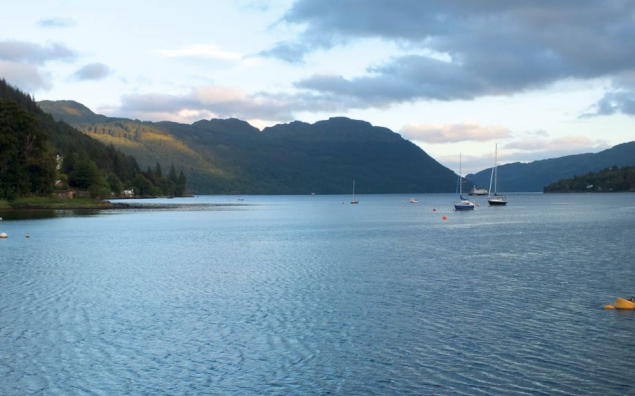
Exploring Loch Goil set deep within the Loch Lomond and Trossachs national park

Passing through the Crinan Canal’s locks can be a tight squeeze
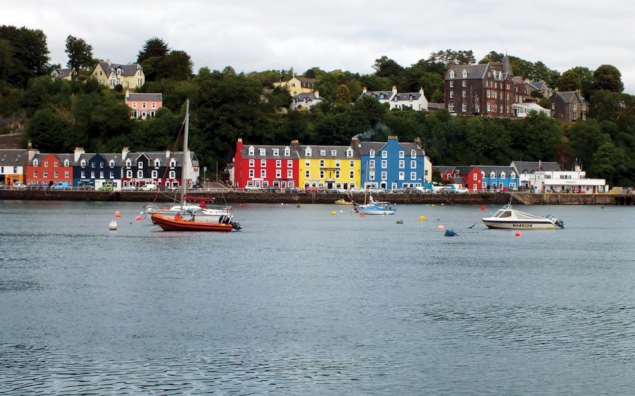
Tobermory’s iconic multi-coloured seafront
